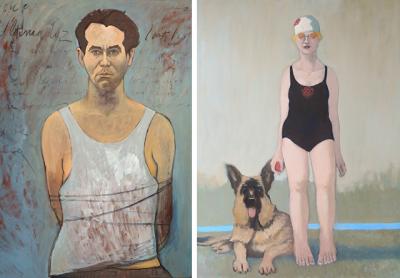Spanish Culture And South Fork Life at Art Space 98

Since opening this spring, Art Space 98, at the upper end of Newtown Lane in East Hampton, has presented an eclectic group of artists. The owners, Rosemarie Schiller and Thomas Buhler, began by showing their own work, then followed with Camille Perrottet’s photography, video, and installation work and Michael Oruch’s geometric abstractions.
They return to realism, or often surrealism, with works by Dennis Snyder, in a show called “Querencia.” Mr. Snyder has explored both Spanish culture and literature and South Fork life in slightly askew renderings for the past several years.
“Querencia” might be thought of as a safe place or happy place, where one feels most at home. For an artist who takes bulls as a subject and bullfighting as motif, it might mean the place in the bullfighting ring where the bull feels both protected and powerful.
Mr. Snyder’s “Querencia: The Red Scented Earth” has a bull in its background, but so much more. In the standing figure with a book at his feet, there is an allusion to the poet Federico Garcia Lorca, who is a recurrent subject of his Spanish-inspired paintings. The figure does not face us; he is looking into the painting, just as we are.
In addition to the bull, he is gazing at a rendering of the Infanta Margarita Teresa as realized some five centuries ago by Diego Velazquez. A princess of Spain who would become a Holy Roman empress, she is the centerpiece of Velazquez’s iconic “Las Meninas.”
Here she has been lifted out of her palace room and away from her courtiers into a mostly flat and arid nether space. A dog lies near her, as in the original painting, but not quite the same dog. The composition feels like a stream of consciousness inflected with dry sherry or a fine Rioja. Maybe it is the artist’s own happy place, a state only accessible through his mind.
Two other paintings in the front room deal with Lorca and are even titled so. These are “Lorca: I Have Not Died” and “Lorca: The Last Poem.” In the first, the poet is portrayed in a gray space with what could be a headstone above him. He appears to be floating above the ground, anchored by ropes tied around his shins. There is something haunting and poetic about the vision, as if heaven (or its inverse) and earth are tussling over his body.
The subject is reminiscent of the Catholic tradition of the “Assumption of Mary,” the belief that Mary’s soul and body were taken to heaven at the end of her life. Titian and Rubens both painted the subject, which can look mystical and even frightening to poor Mary, who has been thought at various times to be alive or dead during her vertical transit. Lorca was 38 when he was executed during the Spanish Civil War in 1936; his body has never been found.
In the other painting, Lorca stands in a grayish blue space with his arms bound and obscured words, presumably his, written on the wall behind him. He looks angry and defiant, and the walls as well as his shirt are smeared with a ruddy color that is most likely blood.
So much attention to Spanish history and culture is bracing and exotic in the context of an East Hampton gallery. Mr. Snyder has been a resident of Southampton for decades, and the paintings on the side wall and in the other room are more reflective of that experience.
In the artist’s words, “Standing between the sky and land, surrounded by the ocean, feeds me and my work. . . . They are all constant influences in all that I do.”
In a series of one-foot-square landscapes lining one gallery wall, a really big sky hangs over a field, wetlands, pond, beach, or dunes. Most of the time the sky is predictably blue or gray, with gradations of cloudiness. In one painting, a blip of red forms a strange, errant cloud that might have been taken out of another painting of a sunset. It’s menacing and delightfully absurd at the same time.
Also absurd is the recurrence of the Infanta as a subject. In these figural paintings of local landscapes, she has been brought into maturity, and is recognizable by the title of the painting as well as the red rosette that decorates her black bathing suit and her white swim cap. These are similar to the one on the child’s dress. In both scenes, a dog lies beside her feet as she stands. In one painting, the red ball in her hand resembles the red posies in the painting of the child.
The red ball reappears in “Watch Your Step,” much larger in form and floating on a pool or body of water of unfathomed depth. The dog in this painting, different from the other two, has an cone collar on his neck and looks tempted to go after the ball. A lone shadowy figure standing in the mist adds another layer of menace and peril.
In fact, a fine mist or haze seems to fall over many of the South Fork subjects, be they straightforward landscapes or more fantastical works. It blurs the vision and urges viewers to re-examine everything they see — not a bad prescription for our present age.
The exhibition is on view through Sunday.
